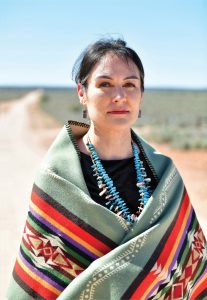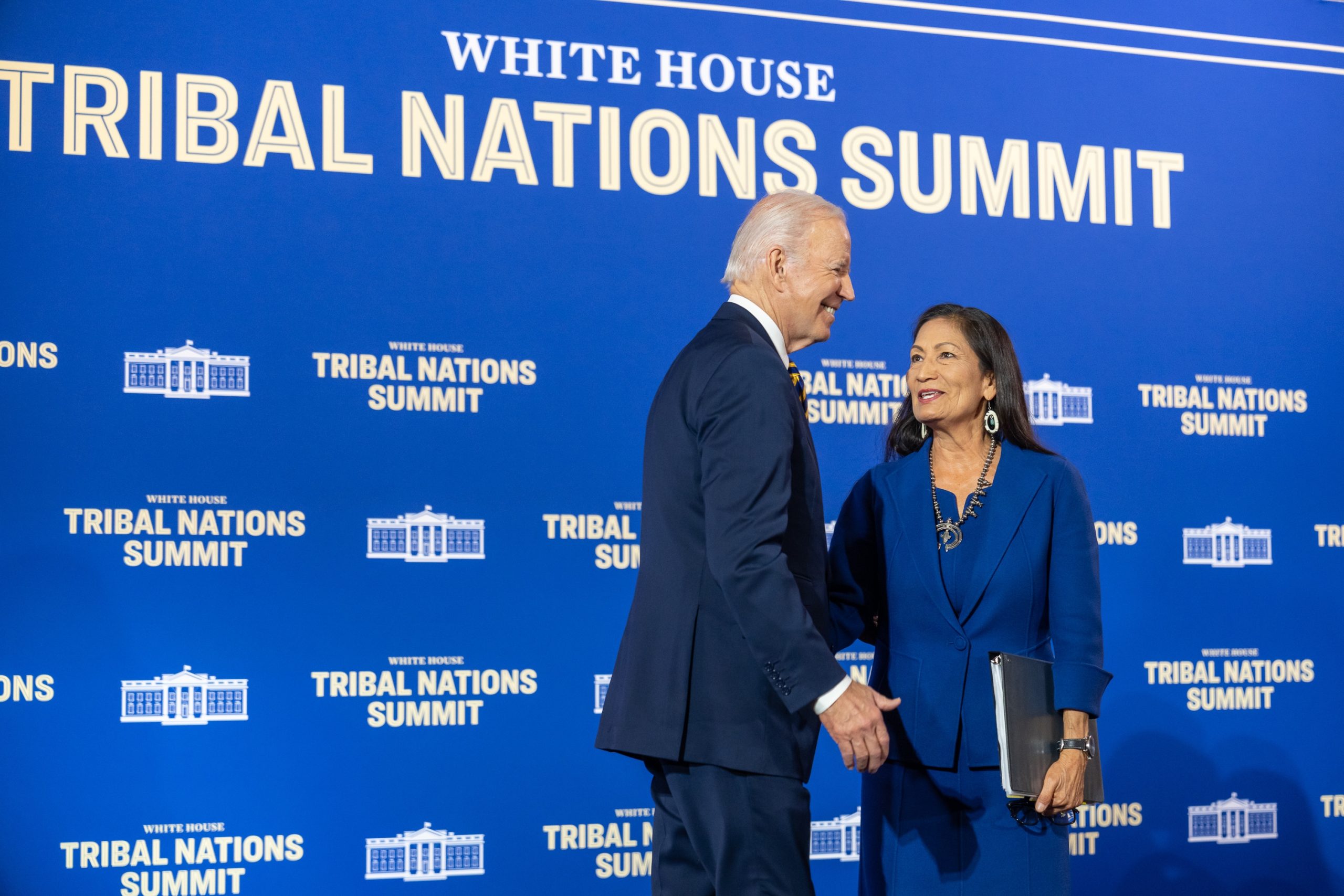Podcast: Play in new window | Download | Embed
When water solutions are discussed, many utility and business leaders are in the room. But at the annual One Water Summit recently held in Tucson, Ariz., some Indigenous youth got a chance to weigh in, too.
Emma VandenEinde reports for the Mountain West News Bureau.
It was the last session of the conference.
Some of the youth were not sure if anyone would show up. But after the session was over, several attendees in the room were in tears.
The youth are members of EcoTruths for Indigenous Youth, a team of students who are taught by elders about the earth and environmental policy.
Eight-year-old Kii’yaa’nii Ross is Diné, Yaqui, and Purepecha. She has one goal in mind.
“In golf courses, they’re wasting a lot of water, like gallons of gallons of water year after year. And they should use dirt instead because, like, come on we’re in the desert.”
Some youth expressed the need to balance housing development with water conservation.
Others want to control water runoff with Native plants. But the youth felt honored that they were listened to and hope more leaders will do the same, as their solutions will impact the rest of their lives.
This story was supported by The Water Desk, an initiative from the University of Colorado Boulder’s Center for Environmental Journalism.

Mazie Countryman outside the U.S. Capital Building during the White House Tribal Youth Forum this November. (Courtesy Mazie Countryman)
A group of Native youth advocates recently attended a Tribal Youth Forum in Washington, D.C.
Wyoming Public Radio’s Hannah Habermann spoke with a young woman from the Wind River Reservation who went to the event.
Mazie Countryman is a sophomore at Idaho State University. In addition to being a full-time student, she’s part of the executive committee for the United National Indian Tribal Youth (UNITY) organization. She’s an enrolled member of the Northern Arapaho tribe.
Countryman, along with ten other Native youth leaders from the group, went to Washington D.C. earlier this month. Countryman spoke on a panel about boarding schools and the Indian Child Welfare Act.
“Most of our grandparents have gone through a residential school and have lived through that, and they just wanted us to give our perspective on how it has affected us through generations.”
The forum is in its third year. Its goal is to create a space for federal officials to hear directly from Native youth.
Countryman says when she graduates she wants to work as a pharmacist on a reservation while continuing to advocate for Native youth.

Young Niizh (Gideon Starr), young Dora (Charlotte Cutler), and young Bezhig (Keris Hope Hill). (Photo: Steve Ackerman / PBS)
Little Bird is now streaming on PBS, and as Hannah Bissett from our flagship station KNBA tells us, it’s a Canadian series that examines self-discovery and the Sixties Scoop.
A new series is making waves in Canada with themes of discovering one’s identity, the Sixties Scoop, and Indigenous narrative sovereignty.
The series is called Little Bird and is streaming on Crave, a streaming platform, and has become one of its first drama series.
What makes this series stand out the most, beyond the material, are the writers and producers behind the series.
Jennifer Podemski is an Anishinaabe (First Nation) and Ashkenazi (Jewish) woman and worked on the show for several years.
She is a producer, actress, and director and began her work on Little Bird as early as 2015.
She has been telling stories from an Indigenous perspective throughout her career.
“It makes, I think, all the difference because the complexity that comes from authentic storytelling is so much more rich and layered and nuanced than what you get when other people tell our stories.”
The series focuses on an Indigenous woman who is taken in something called “the Sixties Scoop, ” a period in the 1950s to 1980s where young Indigenous children were stolen and adopted out to non-Indigenous families as a way to assimilate them.
“Hundreds of thousands of children were moved during the time. And although it does not represent every person’s story, we’ve done our best to create a story that does reflect the most collective experience possible.”
Podemski says that talking about these issues can highlight overlooked parts of history.
“We have a lot of history to retell. In order to catch up with our modern scenarios. And start to imagine ourselves into the future.”
Podemski is hopeful about the impact that stories like Little Bird will have on our future and reshaping traditionally exclusionary media like television to include Indigenous stories by Indigenous people.
Get National Native News delivered to your inbox daily. Sign up for our newsletter today.
 The National Endowment for the Humanities, which provides funding for humanities projects across the country, is working with the Interior Department on the agency’s
The National Endowment for the Humanities, which provides funding for humanities projects across the country, is working with the Interior Department on the agency’s 




 As part of Native American Heritage month, the American Bar Association
As part of Native American Heritage month, the American Bar Association  For Secretary Deb Haaland (Laguna Pueblo), her journey began when she was 28 – a single mom
For Secretary Deb Haaland (Laguna Pueblo), her journey began when she was 28 – a single mom  PBS’ Native America had the last episode of its second season air this week.
PBS’ Native America had the last episode of its second season air this week. This week, a small delegation from the Cherokee Nation attended a U.S. Senate committee hearing on the nomination of Sara Hill to serve as a federal judge in Oklahoma.
This week, a small delegation from the Cherokee Nation attended a U.S. Senate committee hearing on the nomination of Sara Hill to serve as a federal judge in Oklahoma.
 For years, drought and development in the West have caused water shortages for tribes.
For years, drought and development in the West have caused water shortages for tribes. The U.S. Senate passed a bill late Wednesday night to avoid a government shutdown on Friday.
The U.S. Senate passed a bill late Wednesday night to avoid a government shutdown on Friday. More than $9 million has been approved for a project incorporating Native American management practices for oak habitat restoration in Oregon.
More than $9 million has been approved for a project incorporating Native American management practices for oak habitat restoration in Oregon. U.S. Sen. Markwayne Mullin (Cherokee/R-OK) made headlines after a heated confrontation with a witness during a hearing about unions Tuesday in the Health, Education, Labor, and Pensions committee.
U.S. Sen. Markwayne Mullin (Cherokee/R-OK) made headlines after a heated confrontation with a witness during a hearing about unions Tuesday in the Health, Education, Labor, and Pensions committee. Tribal leaders from across the country are gathered in New Orleans for the National Congress of American Indians annual convention where they’re addressing top concerns.
Tribal leaders from across the country are gathered in New Orleans for the National Congress of American Indians annual convention where they’re addressing top concerns. The White House announced Monday that President Joe Biden will host the third annual White House Tribal Nations Summit of his administration on December 6-7.
The White House announced Monday that President Joe Biden will host the third annual White House Tribal Nations Summit of his administration on December 6-7. Meanwhile, tribal leaders from across the country are gathering in New Orleans this week for the National Congress of American Indians annual convention.
Meanwhile, tribal leaders from across the country are gathering in New Orleans this week for the National Congress of American Indians annual convention. Otoe-Missouria Chairman John Shotton is raising concerns about tribal vehicle tags after a recent incident in Oklahoma.
Otoe-Missouria Chairman John Shotton is raising concerns about tribal vehicle tags after a recent incident in Oklahoma. The Shinnecock Indian Nation in New York is hosting a grand opening and ribbon cutting ceremony for Little Beach Harvest Dispensary.
The Shinnecock Indian Nation in New York is hosting a grand opening and ribbon cutting ceremony for Little Beach Harvest Dispensary.